The Martha Graham Dance Company dances The Rite of Spring and Nacho Duato’s Rust at Jacob’s Pillow, August 21-25.
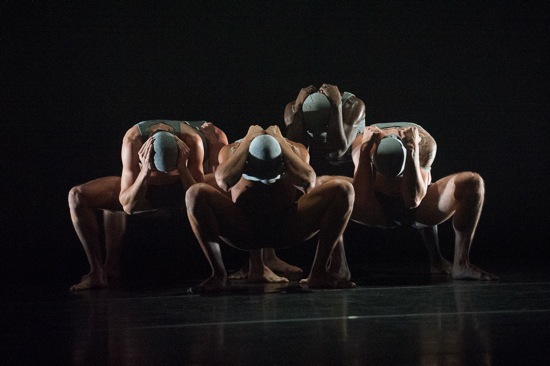
Five men of the Martha Graham Dance Company in Nacho Duato’s Rust. Photo: Christopher Duggan, courtesy of Jacob’s Pillow
I like to imagine that at least once a month this year, somewhere in the world, a dance company and/or an orchestra has been thundering away at Igor Stravinsky’s masterpiece Le Sacre du Printemps, Obviously, I’m no statistician, but it does seem that, in 2013, the centenary of the scandal-cloaked Ballets Russes premiere of the music and Vaslav Nijinsky’s choreography, numerous revivals and new dances set to the score have been performed, and many panels assembled. Or maybe I’m just thinking of all the versions that have been created over the years—by such choreographers as Pina Bausch, Maurice Béjart, Angelin Preljocaj, Molissa Fenley, Glen Tetley, Hans Van Manen, Yvonne Rainer, Paul Taylor, Mark Morris, and by many others.
Among these is Martha Graham’s The Rite of Spring, which premiered in February, 1984. It was perhaps inevitable that the Martha Graham Dance Company’s artistic director, Janet Eilber, would revive it during this year’s Spring fever. Why Graham was persuaded to undertake the work isn’t clear, although she did have a noteworthy personal connection to the music. In 1930, Leopold Stokowski and the Philadelphia Orchestra presented in New York a program that paired Arnold Schoenberg’s Die Glüchliche Hand, a “drama with music,” and Leonide Massine’s Sacre du Printemps, choreographed for Les Ballets Russes in 1920 (the company’s director, Serge Diaghilev, presumably having realized that, over the seven years that had passed since the work’s premiere, audiences had become somewhat acclimated to dissonance and turned-in feet, and knowing that Nijinsky was sinking deeper into madness). Stokowski recruited Graham to dance the role of the “Chosen Maiden.”
The experience was an unusually collegial one for New York’s leading modern dancers. Doris Humphrey and Charles Weidman mimed the leading roles in Die Glüchliche Hand, and the chorus of youths and maidens in Rite was composed of dancers from Graham’s company and the Humprey-Weidman group. Graham and Massine had their differences, but she was, by all accounts spectacular.
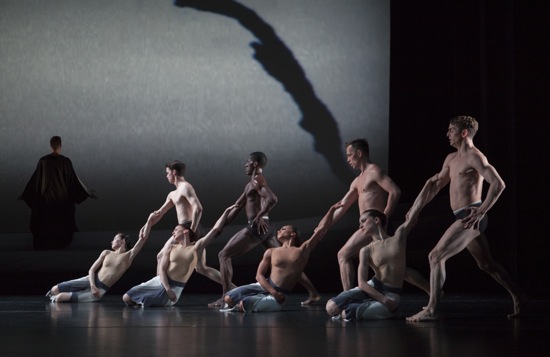
Men and women of the Martha Graham Dance Company in her Rite of Spring. Photo: Sinru Ku, courtesy of Jacob’s Pillow
She was 90 when her Rite premiered. Into it went her memories—not of that earlier version, but of her own dances over the decades. Woven into its powerful fabric and the Stravinsky music are steps you might recognize—the Husbandman from Graham’s Appalachian Spring‘s stampings to pump himself into the air, the male acrobats’ cartwheels in Diversion of Angels, the women’s hunched over leaps in Primitive Mysteries, and all the caving-in falls, sailing turns, and impassioned gestures embedded in the vocabulary that Graham invented. One particular step is wonderfully effective. Striding repeatedly out on one leg, the dancers lift the other (bent) and grasp its foot, straining slightly forward to do this. When they take this move into the air in huge hops, they look both hobbled and predatory.
The revival, as presented in the Ted Shawn Theater at Jacob’s Pillow, does not make use of the original set (designed by Ron Protas); the ritual plays out on a stage backed only by a long, low set of steps (by Edward T. Morris) and a curious and enigmatic projection (by Paul Lieber) that resembles a huge arch of dark, ragged branches. The Shaman (Ben Schultz) no longer wields a staff. Pilar Limosnar has recreated (and somewhat re-envisioned) the original costumes (by Graham and Halston), with long, pale sarongs for the women, worn over flesh-colored leotards that give the impression of bare-breasted celebrants. Fortunately, the men wear trunks more substantial than the buttocks-baring originals.
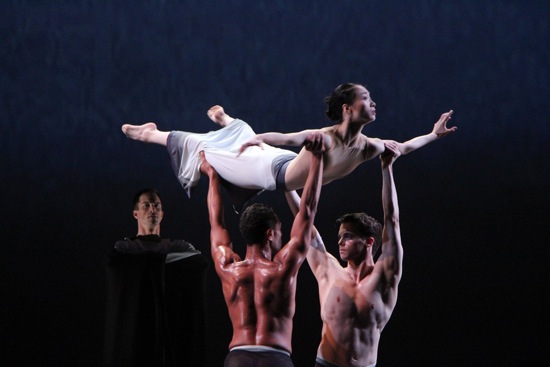
Martha Graham’s The Rite of Spring. Abdiel Jacobsen (L) and Lloyd Mayor lift Xiaochuan Xie as the Chosen One. The Shaman (Ben Schultz) watches. Photo: Charles Eilber, courtesy of the Martha Graham Dance Company.
The first part of the dance is tremendously powerful. In keeping with the strident fervor of some of Stravinsky’s musical passages, the men leap and pound the earth with their feet and hurl themselves to the ground—all this regulated by spatial formations like phalanxes and circles that promote images of ritual. The women—stepping out in a line, weaving among the men, or pairing off with them—are equally assertive. No matter how quiet the music becomes, people in this society have been bred for angularity and thrust.
The moment of choosing of the virgin to be sacrificed demonstrates Graham’s theatricality at its most imaginative. Each of three men swings a woman onto his back and walks along bent over; the women—belly-down, their legs swimming slowly in air—rear their heads up to scan the space and wonder where they’re going. The men are on their way offstage with their burdens when the Shaman—who has been urging the proceedings along and prophesying the redemptive terror to come—simply walks over and plucks the last of the women off her bearer. It seems that she had no inkling of all that she might be in for. (Graham once said, as I remember, that she didn’t choose to be a dancer; she was chosen.)
Another highly theatrical moment. The Shaman wraps the terrified Chosen One in coils of thick rope by running around and around her. Then he picks her up and places her on the steps. Yet his assistants (Tadej Brdnik and Mauricio Nardi) unwind her (maybe tying her up was just to show her that she couldn’t back out). Then, on the music that, in 1913, ushered in the lumbering men in bearskins, the women bring a white skirt and crowd around her, quite tenderly dressing her and loosening her hair. The Shaman carries her around the space, she standing on his shoulders. Queen for a day.
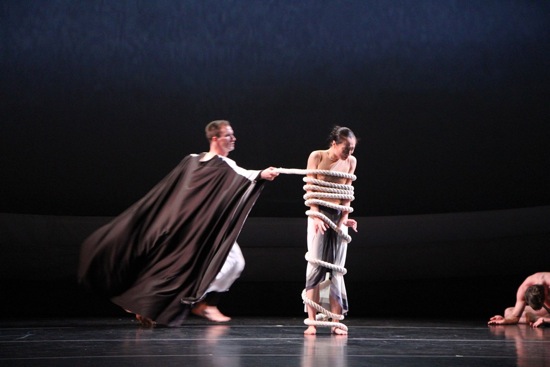
Ben Schultz as the Shaman binds Xiaochuan Xie as the Chosen One. Photo: Charles Eilber, courtesy of the Martha Graham Dance Company
This is the point at which Graham diverges from the Stravinsky-Nijinsky scenario. The young woman (I saw Blakeley White-McGuire, who alternated in the role with Xiaochuan Xie) doesn’t dance herself to death by jumping a hundred or more times (with pauses for trembling). Graham’s jumps in 1930, according to Bessie Schönberg, who saw the Massine Sacre in rehearsal and onstage, were like “little screams.” Instead, Graham’s victim is brutalized both before and after she is garbed, and she—hurling herself around, getting ever more exhausted—dances grief and rage at the role fate has dealt her, with only a few interludes of brave resignation. Interestingly, Graham’s Chosen Maiden is immobile on the music that Stravinsky wrote for her outbursts of dancing. In this society, the men appropriate those passages for their jumps.
The crowd doesn’t stay around to watch, until the very end. They come and go—always in their ranks and lines, always fiercely energetic. At time, even Brdnik and Nardi disappear, and the Shaman waits on the stairs with his back to the sacrificial victim (I believe that in 1984, he never took his eyes off her). No one is watching her but us. A curious, and rather intriguing choice on Graham’s part, as if, two years before her death, she was symbolically divesting herself of her company, her lovers (much takes place between the Shaman and the Chosen One), and, eventually, her career. Blakely-White’s eloquently performed suffering does seem to go on and on.
In the end, the only “Spring” in sight are the pieces of green fabric that Brdnik and Nardi bring in, draped over their shoulders. And, although earlier, the Chosen One has been lifted high, as if being carried on a bier, in death she is hoisted up splayed and hanging at an angle. No reverence for those who kill themselves dancing. Is that what Graham found herself saying? In the end, her Rite is more about the Chosen One than about the society for which she gives her life.
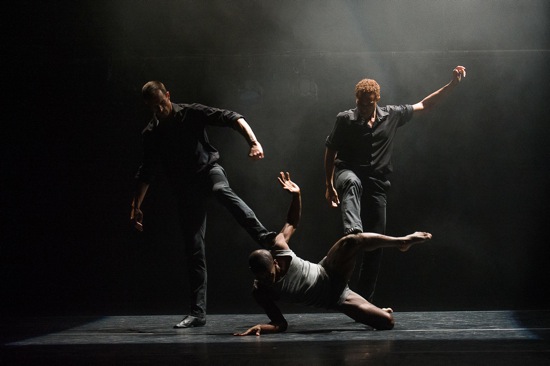
Ben Schultz (L) and Abdiel Jacobsen punish Lloyd Knight in Nacho Duato’s Rust. Photo: Christopher Duggan, courtesy of Jacob’s Pillow
The company also offered a new work. Rust, created this year for the Graham company by Nacho Duato, seems to be a condensation and re-consideration of elements in Herrumbre (Rust), which he created in 2004 for Spain’s Compañia Nacional de Danza. Like Herrumbre, the 2013 Rust deals with the evils of torture and humiliation.
To music by Arvo Pärt and Pedro Alcalde, five terrific men (Brdnik, Nardi, Schultz, Abdiel Jacobsen, and Lloyd Knight) grapple with images that evoke Guantanamo and the war in Iraq. Brad Fields’ superb lighting creates an interplay of darkness and harsh glare and smoke. Brdnik is back-lit when he strides forward to begin the piece, marking him as temporarily sinister and in charge. It is he to whom Knight crawls on his belly after a bout of punishment.
Schultz and Jacobsen brutalize Knight. They twist him and yank his limbs. On every percussive sound, they strike him or bang his head on the floor. But as the viciousness shifts and escalates, and others tangle in other ways, it’s tragically easy for solicitousness to seem punitive, and for violence to appear to initiate camaraderie. When the five cluster, they resemble the sculptured figures in battle monuments.
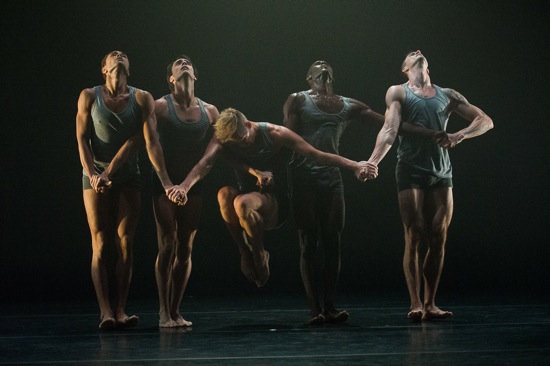
Graham dancers (L to R), Abdiel Jacobsen, Maurizio Nardi, Lloyd Knight, and Ben Schultz hold Tadej Brdnik in Rust. Photo: Christopher Duggan, courtesy of Jacob’s Pillow
Sometimes they lie like fallen soldiers or victims of a bombing. At other times they hurtle around, shot in mid-air or diving for cover. Brdnik vaults and crashes to the floor from a formidable height. When they kneel in sepulchral light, their hands behind their backs, you see that they’ve pulled their tee-shirts back over their heads to hood their faces. An accusatory light beam moves over them and over us, the spectators. Brdnik uncovers his head and walks to his original place; a light makes his shadow on the back wall immense. Everyone else falls, one by one.
Rite of Spring ended a program that included the 2007 Lamentation Variations—visions based on Graham’s iconic 1931 solo by Bulareyaung Pagarlava, Richard Move, and Larry Keigwin. The opener was Graham’s deeply beautiful and uplifting Diversion of Angels (1948). By and large, it was finely performed. Katherine Crockett has found more nuances in her role as the mature woman of the White Couple, with Schultz as her attentive partner. Xie is lovely and frisky as the youthful woman in yellow, vaulting onto the shoulder of her partner (Knight) as if blown there by a breeze. (This iteration of her costume, alas, is more white than yellow.)
At the performance I saw, the dancers personifying the Couple in Red, were Ying Xin and Abdiel Jacobsen. These two are meant to represent lovers in the heat of passion. Xin is, clearly, an excellent dancer, but she performs the role as if she’d rather be playing the Woman in Yellow. Too, that first iconic passage across the stage, when she steps out onto one leg and, tilting to the side, raises the other, has become for her (as for many other dancers) more about quickly lifting the leg as high as it will go and holding it there, instead of about the voyage along that horizontal path. I miss the occasional contraction of the dancer’s upper body (now invisible, or masked by a movement of the raised leg) that once registered as an ecstatic gasp or exhalation.
The four additional women (Mariya Dashkina Maddux, Iris Florentiny, Lucy Postel, and Lauren Newman) and the four men (Schultz, Jacobsen, Knight, and Lloyd Mayor) perform the ensemble passages with fervor. “Strenuous and tender” are words from the Ben Belitt poem that gave Graham her title and some of her inspiration. The choreography reflects those words and much more. Had we seen Diversion of Angels after Rite, we could well have believed that Spring had come.

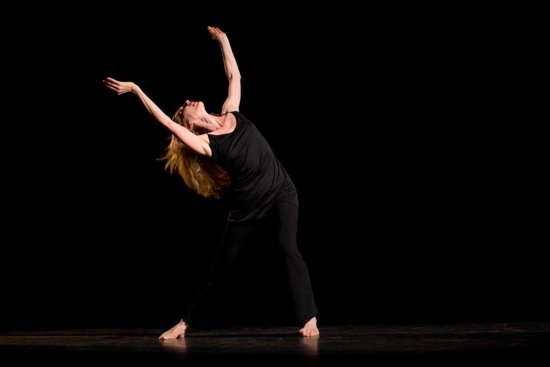
Terrific Deborah, many thanks.
Another wonderful review that makes me wish I had been there. Those hunched over leaps you refer to in Primitive Mysteries were also a great symbol of the Chorus of Furies in Night Journey. And, as for the Lady in Red in Diversion of Angels, the first time I ever saw the Graham Company was back in the 1950s when they came to LA and danced at either the Hollywood Bowl or the Greek Theatre. Pearl Lang danced the part, and the image of her flying across the enormous stage in those deep lunge runs, stopping in a side tilt, as though she had hit an invisible wall, lingering for a moment in stillness before giving a slight gasp (small contraction), twirling around and darting on. I would have greatly missed that moment.
My most vivid memory of Graham’s Diversion of Angels is, like Carol’s, of Pearl Lang dancing the role of the Woman in Red. She was very much of her generation in terms of body and technique—small and slim enough, but with strong, sturdy legs, She was also a beauty, with a big-featured, movie-star face. More important., when she danced in Diversions of Angels, I saw her as afire with love. Not necessarily emitting little flames, but burning hot, llke glowing coals. And, somehow, both radiant and serene.
I must say, Deborah, you fill the space well, with an almost majestic ease. Yet you did that in your Voice columns too. However, I’m glad for the range of details you have room to show here.
I can see in this review some of the dancing, which makes me wish, as it did Carol Egan, that I had been there.
I can see in this review some of the dancing, which makes me wish, as it did Carol Egan, that I had been there.
I found a little interesting and attractive, besides the strong dancers also shows the softness of dance